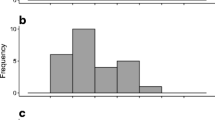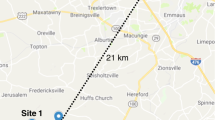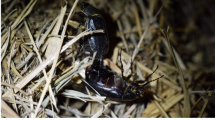Abstract
For insect parasitoids, knowledge of their flight capability is essential for a general understanding of the relationship with their hosts. For instance, flight capacity might partly determine their efficacy as biological control agents. Ibalia leucospoides Hochenwarch (Hymenoptera: Ibaliidae) is a solitary, pro-ovigenic parasitoid of the woodwasp, Sirex noctilio Boidin (Hymenoptera, Siricidae), an economically important pest of softwood forestation. This study explores the flight capacities of I. leucospoides females and assesses the effects of a sugar-rich food supply and crowding on female flight performance, by using computer-linked flight mills. The present study shows: (1) a high variability in flight potential of I. leucospoides females, (2) no effects of food supply and grouping on wasp flight (flight distance and speed), (3) a significant effect of body size and wing loading on flight performance and, (4) a significant body mass loss during the flight dependent on the total distance flown. The lack of effect of food on a highly energy-demanding activity as flight may be related to the life-history traits and nutritional strategies of this parasitoid. The relevance of these observations for the use of I. leucospoides as a biological control agent is discussed.


Similar content being viewed by others
References
Beenakkers AMT (1969) Carbohydrate and fat as a fuel for insect flight, A comparative study. J Insect Physiol 15:353–361
Bernstein C, Jervis MA (2008) Food-searching in parasitoids: the dilemma of choosing between ‘immediate’ or future fitness gains. In: Wajnberg E, Bernstein C, Van Alphen JJM (eds) Behavioral ecology of insect parasitoids: from theoretical approaches to field applications. Blackwell, Oxford, pp 129–171
Berwaerts K, Van Dyck H, Aerts P (2002) Does flight morphology relate to flight performance? An experimental test with the butterfly Pararge aegeria. Functional Ecol 16:484–491
Bianchi FJJA, Booij CHJ, Tscharnkte T (2006) Sustainable pest regulation in agricultural landscapes: a review on landscape composition, biodiversity and natural pest control. Proc R Soc Lond B Biol Sci 273:1715–1727
Blackmer JL, Naranjo SE, Williams LH (2004) Tethered and untethered flight by lygus hesperus and lygus lineolaris (Heteroptera: Miridae). Environ Entomol 33:1389–1400
Bruzzone OA, Villacide JM, Bernstein C, Corley JC (2009) Flight variability in the woodwasp Sirex noctilio (Hymenoptera: Siricidae): an analysis of flight data using wavelets. J Exp Biol 212:731–737
Byrne DN, Buchmann SL, Spangler HG (1988) Relationship between wing loading, wingbeat frequency and body mass in homeopterous insects. J Exp Biol 135:9–23
Chapman RF (1998) The insects: structure and function. Cambridge Univiversity Press, Cambridge
Chrystal RN (1930) Studies of the Sirex parasites. Oxford Forestry Memories No 11. Oxford University Press, London, U.K
Cockbain AJ (1961) Fuel utilization and duration of tethered flight in Aphis fabae Scop. J Exp Biol 38:163–174
Corley JC, Capurro AF, Bernstein C (2004) Prolonged diapause and the stability of host-parasitoid interaction. Theor Popul Biol 65:193–203
Corley JC, Villacide JM, Bruzzone OA (2007) Spatial dynamics of a Sirex noctilio woodwasp population within a pine plantation in Patagonia. Entomol Exp Appl 125:231–236
Corley JC, Villacide JM, van Nouhuys S (2010) Patch time allocation by the parasitoid Ibalia leucospoides (Hymenoptera: Iballidea): the influence of con-specifics, host abundance and distance to the patch. J Insect Behav 23:431–440
Crawley MJ (2007) The R book. Wiley, Chichester
Cronin JT, Reeve JD, Wilkens R, Turchin P (2000) The pattern and range of movement of a checkered beetle predator relative to its bark beetle prey. Oikos 90:127–138
Desouhant E, Driessen G, Lapchin L, Wielaard S, Bernstein C (2003) Dispersal between host populations in field conditions: navigation rules in the parasitoid Venturia canescens. Ecol Entomol 28:257–267
Dudley R, Srygley RB (1994) Flight physiology of neotropical butterflies: allometry of airspeeds during natural free flight. J Exp Biol 191:125–139
Elliott CG, Evenden ML (2009) Factors influencing flight potential of Choristoneura conflictana. Physiol Entomol 34:71–78
Fernández-Arhex V, Corley JC (2005) The functional response of Ibalia leucospoides (Hymenoptera: Ibaliidae), a parasitoid of Sirex noctilio (Hymenoptera: Siricidae). Biocontrol Sci Tech 15:207–212
Fernández-Arhex V, Corley JC (2010) The effects of patch richness on con-specific interference in the parasitoid Ibalia leucospoides (Hymenoptera, Ibaliidae). Insect Sci 17:379–385
Flanders SE (1950) Regulation of ovulation and egg disposal in the parasitic Hymenoptera. Can Entomol 82:134–140
Hassell MP, May RM (1973) Stability in insect host–parasite models. J Anim Ecol 42:693–736
Hoebeke ER, Haugen DA, Haack RA (2005) Sirex noctilio: discovery of a Palearctic siricid woodwasp in New York. Newsletter of the Michigan Entomological Society 50:24–25
Hurley BP, Slippers B, Wingfield MJ (2007) A comparison of control results for the alien invasive woodwasp, Sirex noctilio, in the southern hemisphere. Agric Forest Entomol 9:159–171
Jervis MA, Kidd NAC, Walton M (1992) A review of methods for determining dietary range in adult parasitoids. Entomophaga 37:565–574
Jervis MA, Kidd NAC (1996) Parasitoid adult feeding behaviour and biocontrol: a review. Biocontrol News and Information 17:11–26
Jervis MA, Heimpel GE, Ferns PN, Harvey JA, Kidd NAC (2001) Life-history strategies in parasitoid wasps: a comparative analysis of ‘ovigeny’. J Anim Ecol 70:442–458
Jervis MA, Heimpel GE (2007) Phytophaghy. In: Jervis MA (ed) Insects as natural enemies: a practical perspective. Springer, The Netherlands, p 543
Johnson CG (1969) Migration and dispersal of insects by flight. Methuen, UK
Johnson BGJ, Rowley WA (1972) Age-related ultra-structural changes in the flight muscle of the mosquito. Culex tarsalis. J Insect Physiol 18:2375–2389
Kidd NAC, Jervis MA (2007) Population dynamics. In: Jervis MA (ed) Insects as natural enemies: a practical perspective. Springer, The Netherlands, p 515
King B (1993) Flight activity in the parasitoid wasp Nasonia vitripennis (Hymenoptera: Pteromalidae). J Insect Behav 6:313–321
Lewis WJ, Stapel JO, Cortesero AM, Takasu K (1998) Understanding how parasitoids balance food and host needs: importance to biological control. Biol Control 11:175–183
Lukáš J, Bernstein C, Gu H, Dorn S (2010) Could different environmental conditions select for different flight characteristics in sexual and asexual parasitoid Venturia canescens? Entomol Exp Appl 136:80–88
Madden JL (1968) Behavioural responses of parasites to the symbiotic Fungus associated with Sirex noctilio F. Nature 218:189–190
Madden JL (1981) Egg and larval development in the woodwasp Sirex noctilio. Australian J Zool 29:493–506
Madden JL (1988) Sirex in Australasia. In: Berryman AA (ed) Dynamics of forest insect populations: patterns, causes and implications. Plenum Press, pp 407–427
Martínez A, Fernández-Arhex V, Corley JC (2006) Chemical information from the fungus Amylostereum aerolatum and host foraging behaviour in the parasitoid Ibalia leucospoides. Physiol Entomol 31:1–5
Pelosse P (2008) Rôle des compromis évolutifs dans la spécialisation et la coexistence d’espèces compétitrices. Développements théoriques et expérimentaux chez les insectes parasitoïdes. PhD thesis, Lyon 1 University, France
Rivero A, Casas J (1999) Incorporating physiology into parasitoid behavioural ecology: the allocation of nutritional resources. Res Popul Ecol 41:39–45
Rivero A, Giron D, Casas J (2001) Lifetime allocation of juvenile and adult nutritional resources to egg production in a holometabolous insect. Proc R Soc Lond Biol Sci 268:1231–1238
R Development Core Team (2008) R: A language and environment for statistical computing. R Foundation for Statistical Computing, Vienna, Austria. ISBN 3-900051-07-0, URL http://www.R-project.org
Roff DA (1977) Dispersal in dipterans: its costs and consequences. J Anim Ecol 46:443–456
Roland J, Taylor PD (1997) Insect parasitoide species respond to forest structure at different special scales. Nature 386:710–713
Sappington TW, Fescemyer HW, Showers WB (1995) Lipid and carbohydrate utilization during flight of the migratory moth, Agrotis ipsilon (Lepidoptera: Noctuidae). Arch Insect Biochem Physiol 29:397–414
Schmale I, Wäckers FL, Cardona C, Dorn S (2001) Control potential of three hymenopteran parasitoid species against the bean weevil in stored beans: the effect of adult parasitoid nutrition on longevity and progeny production. Biol Control 21:134–139
Schumacher P, Weyeneth A, Weber DC, Dorn S (1997) Long flights in Cydia pomonella L. (Lepidoptera: Tortricidae) measured by a flight mill: influence of sex, mated status and age. Physiol Entomol 22:149–160
Senger SE, Roitberg BD, Thistlewood HMA (2007) Relative flight responses of Rhagoletis indifferens as influenced by crowding, sex, and resources. Entomol Exp Appl 123:91–100
Shirai Y (1995) Longevity, flight ability and reproductive performance of the diamondback moth, Plutella xylostella (L.) (Lepidoptera: Yponomeutidae), related to adult body size. Res Popul Ecol 37:269–277
Siekmann G, Tenhumberg B, Keller MA (2001) Feeding and survival in parasitic wasps: sugar concentration and timing matter. Oikos 95:425–430
Sirot E, Bernstein C (1996) Time sharing between host searching and food searching in solitary parasitoids: state dependent optimal strategies. Behav Ecol 7:189–94
Spradbery JP (1970a) Host finding by Rhyssa persuasoria, an ichneumonid parasite of siricid woodwasps. Anim Behav 18:103–114
Spradbery JP (1970b) The biology of Ibalia drewseni Borries, a parasite of siricid woodwasps. Proc Entomol Soc London B 45:104–113
Spradbery JP (1977) The oviposition biology of siricid woodwasps in Europe. Ecol Entomol 2:225–230
Stapel JO, Cortesero AM, De Moraes CM, Tumlinson JH, Lewis WJ (1997) Extrafloral nectar, honeydew and sucrose effects on searching behavior and efficiency of Microplitis croceipes (Hymenoptera: Braconidae) in cotton. Environ Entomol 26:617–623
Suarez RK, Darveau CA, Welch KC, O’Brien DM, Roubik DW, Hochachka PW (2005) Energy metabolism in orchid bee flight muscles: carbohydrate fuels all. J Exp Biol 208:3573–3579
Tenhumberg B, Siekmann G, Keller MA (2006) Optimal time allocation in parasitic wasps searching for hosts and food. Oikos 113:121–131
Takasu K, Lewis WJ (1995) Importance of adult food sources to host searching of the larval parasitoid Microplitis croceipes. Biol Control 5:25–30
Vogt JT, Appel AG, West MS (2000) Flight energetics and dispersal capability of the fire ant. Solenopsis invicta Buren. J Insect Physiol 46:697–707
Wanner H, Gu H, Dorn S (2006) Nutritional value of floral nectar sources for flight in the parasitoid wasp, Cotesia glomerata. Physiol Entomol 31:127–133
Yu H, Zhang Y, Wu K, Wyckhuys KAG, Guo Y (2009) Flight potential of Microplitis mediator, a parasitoid of various lepidopteran pests. BioControl 54:183–193
Acknowledgments
We acknowledge financial support from ANPCyT, Argentina (PICT 0-1200/06), CNRS, France (PICS 4144) and INTA, Argentina. We thank C. Lazzari, P. Pelosse and D. Giron for their valuable comments on an earlier version of the manuscript. We thank Enzo Sauro (Centro Atómico Bariloche) for helping us design the computer interface board.
Author information
Authors and Affiliations
Corresponding author
Rights and permissions
About this article
Cite this article
Fischbein, D., Corley, J.C., Villacide, J.M. et al. The Influence of Food and Con-specifics on the Flight Potential of the Parasitoid Ibalia leucospoides . J Insect Behav 24, 456–467 (2011). https://doi.org/10.1007/s10905-011-9270-z
Revised:
Accepted:
Published:
Issue Date:
DOI: https://doi.org/10.1007/s10905-011-9270-z




